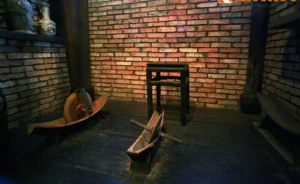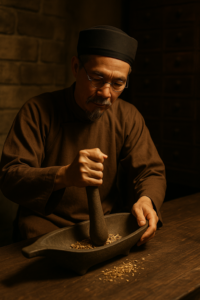Introduction
Within the treasure trove of Vietnam’s traditional medical heritage, the image of the herb-grinding boat (thuyền tán thuốc) stands as a vivid symbol of the meticulousness, dedication, and resilience of the traditional healer. It is not merely a medicinal tool—it is a testament to a humanistic medicine, where each herbal grain represents the effort and moral integrity of the physician.

What is the Herb-Grinding Boat?
The herb-grinding boat is a traditional instrument used to grind medicinal herbs into fine powder, serving in the preparation of powdered remedies, pill forms (hoàn), or topical applications.
Structure:
-
Boat: Resembling a shallow trough or miniature boat, commonly made of stone, bronze, or alloy.
-
Grinding Pestle: Cylindrical with a handle, used for crushing and grinding herbs along the surface of the boat.
The grinding process demands steady pressure, skillful technique, and great patience to achieve the desired fineness required for each specific remedy.
Its Role in Traditional Medicine
For centuries, the herb-grinding boat has been an indispensable tool in:
-
Traditional Oriental clinics
-
Herbal medicine shops
-
Family-run apothecaries
The image of a physician or assistant, sitting beside the stone boat, steadily moving the pestle while softly reciting prescriptions, is a poetic representation of traditional Vietnamese medical practice.

Timeless Values
Beyond functionality, the herb-grinding boat carries symbolic meaning:
-
🎓 Folk wisdom passed down through generations
-
🧡 Medical ethics—dedication and precision in each stage of drug preparation
-
🕰 Cultural heritage of the traditional medical profession to be preserved
Though modern machines have replaced much of the manual labor, the grinding boat remains in medical museums as a tangible memory of a fading era.
Conclusion
The herb-grinding boat is more than just a tool—it is a reflection of an era when the preparation of medicine was considered an art form. Every movement of the pestle on stone affirms the traditional belief in “medicine made with devotion,” where the healer is both a craftsman and a guardian of Eastern wisdom.

